Correlation of Visible-Residue Limits with Swab Results for Cleaning Validation
The correlation between swab assay results and visible-residue limits (VRLs) for cleaning validation was examined. Previously completed validation studies were reviewed to compare swab results with recently determined VRLs. A current cleaning validation study evaluated both swab testing and VRL. Unexpected swab results led to an investigation, which showed the value of establishing the VRL in conjunction with swab recoveries for cleaning validation programs.
The use of visual inspection as a criterion for equipment cleanliness has always been a component of cleaning validation programs. Mendenhall proposed the use of only visual examination to determine equipment cleanliness as long ago as 1989 (1). He concluded that visible cleanliness criteria were more rigid than quantitative calculations and clearly adequate. The US Food and Drug Administration limited the use of visually clean criterion between lots of the same product (2). LeBlanc raised the question of whether a visible limit as the sole acceptance criterion could be justified (3).
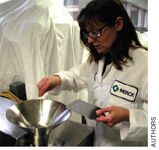
A visible-residue limit (VRL) currently is used in a clinical pilot plant for the introduction of new compounds (4, 5) in cases for which the VRL is lower than the acceptable-residue limit (ARL). The ARL is the amount of a formulation component that can be carried over to the next formulation with no pharmacological or adulteration concerns. The initial use of an active pharmaceutical ingredient (API) in the facility is followed by cleaning and a visual inspection against the previously determined VRL. Visually clean equipment means the current cleaning procedure is effective and the new API is not a new worst case that would require cleaning validation.
The same scientific rationale supports the use of VRLs in a manufacturing facility. The main difference between pilot plant and commercial manufacturing facilities is equipment size. Acceptable viewing parameters for the larger manufacturing equipment, including distance, viewing angle, and light level, consistently detect VRLs for several marketed formulations (6).
The implementation of VRLs in the pilot plant and their potential use in the manufacturing facility were additions to established cleaning programs. The cleaning programs in both the pilot plant and manufacturing facilities established validation based on swab sample data using high-performance liquid chromatography (HPLC) for analysis. Visual inspections were part of the validation, but were qualitative determinations only.
It should be possible to demonstrate the correlation between the quantitatively determined VRL of either the API or formulation on the manufacturing equipment and the analytically determined swab recovery data. The data from the two determinations should be mutually supportive as part of a cleaning process validation. Therefore, a retroactive analysis of the pilot-plant validation study compared the previously obtained swab results with the more recently generated VRLs for the subject compounds.
In addition, a current cleaning validation study conducted in a clinical packaging area included VRL as an integral part of the study. The study used documented worst-case formulations to soil the equipment, followed by cleaning according to a standard operating procedure. Visual inspection used experimentally determined VRLs. Swab samples for the appropriate compound confirmed the equipment's cleanliness. Testing for each formulation was repeated twice to validate the cleaning procedure. The final report includes a comparison between the VRLs and the swab sample results.
Although the cleaning validation passed testing (i.e., all swab results were lower than the ARL), the swab results for several metformin samples assayed higher than the experimentally determined VRL. An investigation reconciled the discrepancy.
Retrospective analysis
The cleaning-validation study for the pilot plant selected worst-case formulations. One formulation was validated for a dry-granulation equipment train and another for the wet-granulation process. Each piece of cleaned equipment was visually inspected before swab testing and both formulations were tested three times for validation.
The compounds tested were simvastatin and rofecoxib (Whitehouse Station, NJ, Merck & Co., Inc.). Four observers viewed dried solution spots of known concentrations to determine the VRLs. The experimentally derived VRLs for the compounds were 0.485 and 0.871 μg/cm2 , respectively (4). For a swab area of 25 cm2 , the limits were 12.1 and 21.8 μg/swab. The VRLs for the base and neutral detergents used to clean the equipment were <0.37 and <0.56 μg/cm2 (<9.3 and <14 μg/swab).
Of the 78 swabs taken for simvastatin, all were below the VRL of 12 μg/swab. This finding confirms that the equipment was visually clean when swabbed. Of the 78 swabs, 64 had no simvastatin detected (less than 0.1 μg/swab), nine had less than 1 μg/swab, and 5 had more than 1 μg/swab.
Eighty-four swabs were taken for rofecoxib, and all were below the VRL of 21.8 μg/swab. Of these, 55 had no rofecoxib detected (less than 0.02 μg/swab), 23 were less than 1 μg/swab, and only 6 were greater than 1 μg/swab.
Finally, of the 69 detergent swabs taken, 68 had no detergent detected (<3 μg/swab) and the remaining swab had less than the 14-μg/swab VRL.
Although all 231 swabs from the cleaning validation study showed agreement between the swab results and VRLs, only 5% of the swabs were greater than 1 μg/swab. The validated cleaning process reduced residues far below both the ARL and the VRL levels. Therefore, the pilot-plant cleaning-validation study did not seriously challenge the correlation between the swab results and the VRLs.
Experimental
Cleaning validation. The current cleaning validation study established the requirements and acceptance criteria for the following equipment in the clinical packaging area: tablet counter, automatic filler, 8-track filler, and tablet elevator. The validation of the cleaning procedures was on equipment that had been used to fill and package clinical product and then cleaned. A development formulation and 500-mg metformin tablets served as representative worst-case formulations for validation. Both products are non film-coated tablets, which produce dust during the packaging process. The metformin tablets had a very high drug load (95%) and any residual dust was most likely to be API.
Before the first cleaning trial, a VRL was established for both compounds. Each formulation was dispersed in methanol and spotted on 3 × 6-in. stainless steel coupons at appropriate concentrations. A stream of nitrogen dried the spots to facilitate the drying process and prevent potential degradation of the material. Oxidative degradation had occurred on several in-house compounds in the past. The areas of the dried spots determined the amount-per-unit area (μg/cm2 ) value for each spot of material (Table I). The VRL determined for the development compound was 0.51 μg/cm2 (12.75 μg/swab) and 0.97 μg/cm2 (24.25 μg/swab) for metformin.
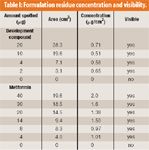
Table I: Formulation residue concentration and visibility.
The cleaning validation was performed in triplicate on representative pieces of equipment. Validation consisted of overall visual inspection and swab sampling in the areas identified in the protocol. These areas had been identified as hard-to-clean areas of the equipment to confirm that the cleaning procedure removed residue to acceptable levels as predetermined by the established 100 μg/swab (25 cm2 ) acceptance criteria for the API. The swab samples were assayed with a validated HPLC method (Agilent 1100 HPLC, Agilent Technologies, Palo Alto, CA) with ultraviolet diode array detection (Tables II and III).
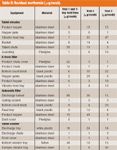
Table II: Residual metformin (μg/swab).
The cleaning procedures used the appropriate cleaning standard operating procedure to verify the repeatability of the cleaning processes to control residue. In addition, during one of the three validation trials for each piece of equipment, a seven-day "dirty" hold time established the longest allowable time between the completion of the filling and packaging process and the start of the subsequent cleaning process.
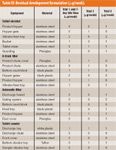
Table III: Residual development formulation (μg/swab).
The acceptable API limit for the clinical packaging equipment was 100 μg/swab (25 cm2 ). This limit was based on adulteration of the subsequent batch of packaged material. The adulteration limit was used exclusively because any material with a potential safety concern is packaged in an isolated facility and equipment cleaning is addressed on a case-by-case basis. In addition, product contact with the equipment was limited in this case compared with manufacturing equipment because the formulation was in final market image.
Investigation. The investigation into the VRL and swab numbers for metformin targeted the assay method, the cleaning method, and the VRL determination of the API and formulation. The swab samples' testing was by HPLC and the assay run was reviewed as well as the method validation data. The cleaning process used in the clinical packaging area was reviewed for potential chemical interactions. The VRL determination of metformin was investigated for potential issues.
Results and discussion
Cleaning validation. A cleaning-validation study was completed successfully in a clinical packaging facility. The study used the worst-case packaging situations and all swab samples assayed below the ARL of 100 μg/swab (see Tables II and III) for the three executions (including 7-day idle time before cleaning). The cleaning processes used in the clinical packaging area are considered validated for hold times as long as 7 days.
The only problem was the discrepancy between the swab results for metformin and the VRL. The VRL data indicated that anything greater than 25 μg/swab should have been detected visually. A visual inspection of the equipment before sample swabbing concluded that it was visually clean.
Investigation. The investigation into the discrepancy between the metformin VRL and swab data began with the HPLC assay of the samples. Nothing was consistently present in the samples to suggest contamination of the swabs or solvents because the majority of the samples (58 of 69) had assay values below the VRL (see Figures 1a, 2a). Nothing in the sample chromatograms indicated the presence of an intermittent extraneous peak, which might explain the high results. The chromatogram of a control containing a swab, swabbing solvent, and extraction solvent showed no peaks. The system suitability data were within testing parameters. The HPLC assay did not indicate a potential cause.
The method-validation data and documentation review indicated that all validation parameters were within accepted guidelines, including recoveries from stainless steel coupons. Forced degradation studies of metformin showed no degradate peaks to explain the observed swab results.
The cleaning process for equipment in the clinical packaging area consisted of an appropriate amount of equipment disassembly such that all surfaces were accessible. A dry vacuum removed most residue from the equipment. The equipment surfaces were cleaned with an appropriate solvent and then dried before reassembly. A sample of metformin prepared in the cleaning solvent showed no evidence of degradation.
A review of the VRL determination for metformin noted that the VRL samples were dried under nitrogen to prevent potential oxidation of the material, which had been noted on a previous compound. The VRL study was repeated using API and formulation dispersed in alcohol, but the samples were air dried rather than under nitrogen to simulate drying conditions in the packaging area. Sample concentrations were at the VRL of 25 μg/swab level and at the approximate level of the highest sample obtained during the validation studies, 75 μg/swab. Spots were applied in triplicate to 3 × 6-in. stainless steel coupons.
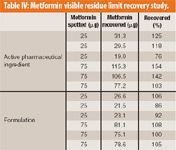
Table IV: Metformin visible residue limit recovery study.
A visual examination of the metformin residues confirmed that the 25-μg/swab spots were visible. The 75-μg/swab spots exhibited a proportionally greater amount of visible residue. The metformin residues were swabbed and assayed by HPLC. The swab results from the formulation (see Table IV) matched the nominal residue amounts. Nonetheless, several swab results for the 25-and 75-μg API spots were significantly higher. As with the HPLC assays for the cleaning validation samples from the packaging area, no contaminants or extraneous peaks were present to explain the intermittent high results.
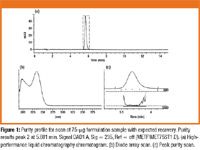
Figure 1
Diode array scans were taken of two of the 75-μg API samples; one with the expected recovery and one with high recovery. The scans were not significantly different (see Figures 1b, 2b), indicating that the peaks were related, if not the same. A peak purity profile for the sample with the expected recovery indicated that the peak was pure. The peak purity scan for the sample with higher than expected recovery indicated that more than one species was present in the scan (see Figures 1c, 2c). Mass spectrometry (MS) and nuclear magnetic resonance analyses of the samples were inconclusive. The sample concentrations were too low for positive identification.
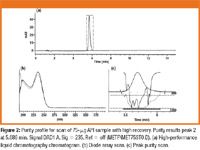
Figure 2
In portions of some samples, the data indicated that one metformin double bond rearranged to form a set of conjugated double bonds (see Figure 3). The conjugated double-bond system exhibits greater ultraviolet absorbance than metformin where the double bonds are not conjugated. This finding explains the inconsistent, high swab recoveries, the single HPLC peak, and the diode-array impure peak composition. The manufacturer and most literature sources cite the nonconjugated version as the chemical structure for metformin. But, at least one source (7) displayed the alternate structure in Figure 3 as the chemical structure of metformin, supporting the conclusion deduced from the available data.
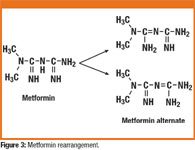
Figure 3
Several compounds have been tested that degraded during recovery studies. The compounds were known to be susceptible to either by oxidation or hydrolysis. Metformin was the first example of a compound that demonstrated increased absorbance as a result of the cleaning process. Any chemical change during recovery studies will affect recovery results as well as swab assays taken after routine cleaning. The current study demonstrated the value of establishing the VRL along with swab recoveries for cleaning validation.

The swab process.
Conclusions
The correlation between swab assay results and visible-residue limits (VRLs) for cleaning validation was examined. A review of previously completed validation studies was inconclusive because swab results were much lower than the more-recently determined VRLs. A current cleaning-validation study evaluated both swab testing and VRLs. Unexpectedly, high swab results led to an investigation that showed the value of establishing the VRL in conjunction with swab recoveries for cleaning-validation programs.
Richard Forsyth* is an associate director in Global Clinical GMP Quality with Merck & Co., Inc., WP53C-307, West Point, PA 19486, tel. 215.652.7462, fax 215.652.7106, richard_forsyth@merck.com Julia Roberts is a research chemist in Vaccine Pharmaceutical Research, Tara Lukievics is a global sourcing project leader in the Global Clinical Supplies Organization, and Vincent Van Nostrand is a research chemist in medicinal chemistry with Merck & Co., Inc.
*To whom all correspondence should be addressed.
Submitted: May 16, 2006. Accepted: May 25, 2006. Keywords: cleaning, validation, visible-residue limits
References
1. D.W. Mendenhall, "Cleaning Validation," Drug Develop. Indust. Pharm. 15 (13), 2105–2114 (1989).
2. US Food and Drug Administration, Guide to Inspection of Validation of Cleaning Processes (Rockville, MD, Office of Regulatory Affairs, 1993).
3. D.A. LeBlanc, "'Visually Clean' as a Sole Acceptance Criteria for Cleaning Validation Protocols," J. Pharm. Sci. and Technol. 56 (1) 31–36 (2002).
4. R.J. Forsyth, V. Van Nostrand, and G. Martin, "Visible Residue Limit for Cleaning Validation and its Potential Application in a Pharmaceutical Research Facility," Pharm. Technol. 28 (10), 58–72 (2004).
5. R.J. Forsyth and V. Van Nostrand, "The Use of Visible Residue Limit for Introduction of New Compounds in a Pharmaceutical Research Facility," Pharm. Technol. 29 (4), 134–140 (2005).
6. R.J. Forsyth and V. Van Nostrand, "Application of Visible Residue Limit for Cleaning Validation in a Pharmaceutical Manufacturing Facility," Pharm. Technol. 29 (10), 152–161 (2005).
7. National Center for Biotechnology Information, National Library of Medicine, National Institutes of Health, www.nvbi.nlm.nih.gov.
